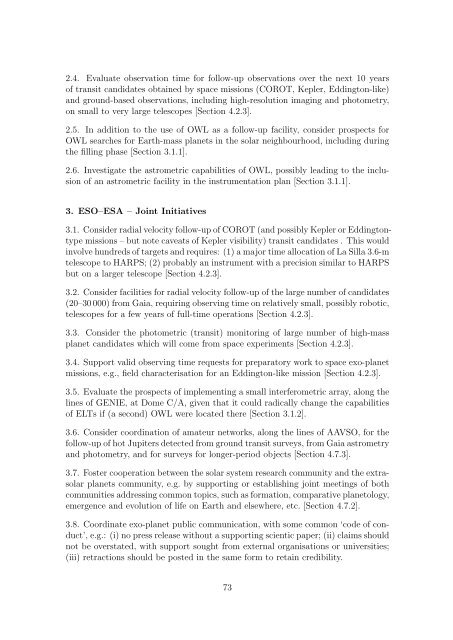Report - School of Physics
Report - School of Physics
Report - School of Physics
Create successful ePaper yourself
Turn your PDF publications into a flip-book with our unique Google optimized e-Paper software.
2.4. Evaluate observation time for follow-up observations over the next 10 years<br />
<strong>of</strong> transit candidates obtained by space missions (COROT, Kepler, Eddington-like)<br />
and ground-based observations, including high-resolution imaging and photometry,<br />
on small to very large telescopes [Section 4.2.3].<br />
2.5. In addition to the use <strong>of</strong> OWL as a follow-up facility, consider prospects for<br />
OWL searches for Earth-mass planets in the solar neighbourhood, including during<br />
the filling phase [Section 3.1.1].<br />
2.6. Investigate the astrometric capabilities <strong>of</strong> OWL, possibly leading to the inclusion<br />
<strong>of</strong> an astrometric facility in the instrumentation plan [Section 3.1.1].<br />
3. ESO–ESA – Joint Initiatives<br />
3.1. Consider radial velocity follow-up <strong>of</strong> COROT (and possibly Kepler or Eddingtontype<br />
missions – but note caveats <strong>of</strong> Kepler visibility) transit candidates . This would<br />
involve hundreds <strong>of</strong> targets and requires: (1) a major time allocation <strong>of</strong> La Silla 3.6-m<br />
telescope to HARPS; (2) probably an instrument with a precision similar to HARPS<br />
but on a larger telescope [Section 4.2.3].<br />
3.2. Consider facilities for radial velocity follow-up <strong>of</strong> the large number <strong>of</strong> candidates<br />
(20–30 000) from Gaia, requiring observing time on relatively small, possibly robotic,<br />
telescopes for a few years <strong>of</strong> full-time operations [Section 4.2.3].<br />
3.3. Consider the photometric (transit) monitoring <strong>of</strong> large number <strong>of</strong> high-mass<br />
planet candidates which will come from space experiments [Section 4.2.3].<br />
3.4. Support valid observing time requests for preparatory work to space exo-planet<br />
missions, e.g., field characterisation for an Eddington-like mission [Section 4.2.3].<br />
3.5. Evaluate the prospects <strong>of</strong> implementing a small interferometric array, along the<br />
lines <strong>of</strong> GENIE, at Dome C/A, given that it could radically change the capabilities<br />
<strong>of</strong> ELTs if (a second) OWL were located there [Section 3.1.2].<br />
3.6. Consider coordination <strong>of</strong> amateur networks, along the lines <strong>of</strong> AAVSO, for the<br />
follow-up <strong>of</strong> hot Jupiters detected from ground transit surveys, from Gaia astrometry<br />
and photometry, and for surveys for longer-period objects [Section 4.7.3].<br />
3.7. Foster cooperation between the solar system research community and the extrasolar<br />
planets community, e.g. by supporting or establishing joint meetings <strong>of</strong> both<br />
communities addressing common topics, such as formation, comparative planetology,<br />
emergence and evolution <strong>of</strong> life on Earth and elsewhere, etc. [Section 4.7.2].<br />
3.8. Coordinate exo-planet public communication, with some common ‘code <strong>of</strong> conduct’,<br />
e.g.: (i) no press release without a supporting scientic paper; (ii) claims should<br />
not be overstated, with support sought from external organisations or universities;<br />
(iii) retractions should be posted in the same form to retain credibility.<br />
73
















